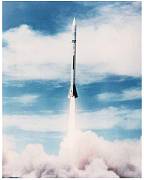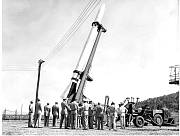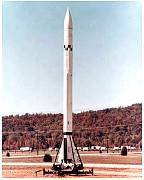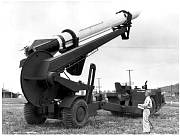Known as the embryo of the Army missile programs the CORPORAL was a
surface-to-surface guided missile which could deliver either a nuclear or high-explosive
warhead up to a range of 75 nautical miles. The first CORPORAL battalion was deployed in
Europe in 1955. This system remained in the field until 1962-63 when it was replaced by
the SERGEANT missile system.
View more CORPORAL photos

System Chronology
May 44 - ORDCIT Project, the first U.S. Army Ordnance integrated missile project planned to progress from a test vehicle to a guided missile, was initiated at the California Institute of Technology (CIT). The Jet Propulsion Laboratory (JPL) was organized soon thereafter.
24 May 44 - The first interim contract was awarded for research and development leading to long-range rocket missiles.
22 June 44 - The first definitive contract for U.S. missile research was placed with JPLICIT, providing for the orderly development of rocket test vehicles and all related fields, leading eventually to the tactical CORPORAL, by way of the PRIVATE A, PRIVATE F, without altitude control (WAC) CORPORALS A &B, BUMPER WAC, and CORPORAL E.
1 July 44 - The Research and Development Service Sub-Office
(Rocket) was established at CIT.
November 44 - Studies, theoretical calculations (including
trajectories), and drawings of a tentative CORPORAL had already begun to take form.
December 44 - The first firings of a test vehicle as part of the first integrated development program designed to lead to a guided missile occurred at Leach Lake, Leach Springs, California. The test vehicle fired was the PRIVATE A, the first U.S. step-rocket. It was crude, but a step-rocket nevertheless.
2 January 45 - Establishment of the first large-thrust rocket
motor test station, together with all related facilities, was approved. Located at Muroc,
California, the motor to be tested was the 20,000-pound-thrust CORPORAL motor, the first
motor of such high thrust to be designed and built in the United States.
February-April 45 - PRIVATES A & F as well as crude CORPORAL rocket models were subjected to supersonic wind tunnel tests at Aberdeen Proving Ground, the first such Army Ordnance tests of rocket models.
April 45 - PRIVATE F firings were the first to prove that winged ballistic missiles required guidance control to effect stability in flight.
25 June 45 - Work was started on the construction of facilities at the newly acquired White Sands Proving Ground, necessitated by the development of the ORDCIT Project.
26 September 45 - TINY TIM, the booster for the WAC CORPORAL, was the first rocket to be test fired at White Sands Proving Ground.
26 September 45 - An altitude of 43.5 miles was reached by the
first WAC CORPORAL, whose booster was a modified TINY TIM rocket. This was the first U.S.
liquid-propellant rocket developed with Government funds.
1 October 45 - WAC CORPORAL A (quarter-charged), the first U.S. high-altitude test rocket and the first U.S. two-stage rocket to demonstrate the successful separation of the first from the second stage in free-flight (outside launcher), was also the first rocket to carry a nose release recovery system, even though its operation was unsuccessful.
11 October 45 - WAC A Round 5 was the first U.S. missile to carry radiosonde equipment, although it failed to function. Round 5 reached a 235,000-foot altitude, a record for a U.S. test vehicle.
11 October 45 - The 1st Guided Missile Battalion was activated at Fort Bliss, Texas.
12 October 45 - WAC A Round 6 was the first U.S. missile to carry a "radar window," or beacon.
19 October 45 - JPL deeded the U.S. Government 31.5 acres along
with the facilities occupying the land tract, making the U.S. Government the owner of the
Jet Propulsion Laboratory.
Late 1945 - The first U.S. large-thrust rocket motor was
tested at the new Muroc test stand.
6 December 46 - Round 12 of the WAC firings at White Sands Proving Ground was the first WAC B, with a newly designed, much lighter motor. It was the first U.S. missile to carry oxidizer and fuel burst-diaphragms. Burst-diaphragms proved their value during the WAC B and BUMPER firings and persisted throughout the CORPORAL development and deployment phases. Round 12 also had the first successful parachute operation. The entire missile was recovered.
12 December 46 - WAC B Round 14 was the first to demonstrate the successful recovery of instrumentation (telemetry).
22 May 47 - The first U.S. ballistic missile was successfully
fired. The CORPORAL E, the first U.S. surface-to-surface guided ballistic missile,
accepted guidance corrections, attaining a range of 63.5 miles and an altitude of 129,000
feet. It was powered by the first U.S. developed and tested large-thrust rocket motor,
essentially a scaled-up WAC motor.
Spring 1947 - Battery D, 1st Guided Missile
Battalion, furnished the first all-soldier crew ever to fire a missile in the United
States. They fired a WAC CORPORAL B.
20 June 47 - Ordnance established as part of the HERMES Project being conducted by General Electric development of a two-stage research vehicle-the BUMPER-which was to consist of the WAC B mated to the German V-2 (or A-4).
13 May 48 - BUMPER Round 1, with a partially charged,
solid-propellant second stage (Dummy WAC), was successfully fired at White Sands Proving
Ground. This was the first large, two-stage rocket to be launched in the Western
hemisphere. Inflight separation was proved.
1 November 48 - BUMPER WAC Round 4 was the first U.S. missile to have a burst-diaphragm over the exhaust nozzle, designed to ensure proper motor starting conditions at high altitudes by preserving ground-atmospheric conditions for second-stage start.
1949 - Seven CORPORAL E airframes were produced by Douglas
Aircraft Company to be used in the research and development firings, with JPL installing
the guidance and control components.
24 February 49 - A U.S. missile first penetrated outer space. BUMPER WAC CORPORAL Round 5 was the first missile to be used to measure temperatures at extreme altitudes; the first to carry telemetry which transmitted to ground stations technical information concerning conditions encountered during flight; and the first to demonstrate the feasibility of the separation of two-stage rockets at very high altitudes. This was the first time radio equipment had ever been operated at such extreme altitudes. Round 5 attained a speed of 5,150 miles per hour and an altitude of about 244 miles, the greatest velocity and highest altitude ever reached by a man-made object.
21 April 49 - BUMPER WAC Round 6 was the first U.S. test
vehicle designed to obtain cosmic ray data at altitudes unattainable by other rockets,
although the first stage V-2 failed.
7 June 49 - CORPORAL E Round 4 proved CORPORAL's modified propulsion system, (including newly designed, axially cooled, 125-pound motor). This was basically the same system persisting all the way to the tactical CORPORAL.
22 September 49 - Ordnance decided to modify the CORPORAL E to fill the requirement for an interim guided missile system. This was designated the CORPORAL Type I. The latter was the first U.S. tactical guided missile.
18 January 50 - JPL was directed by the Chief of Ordnance to
expedite CORPORAL development toward the goal of interim tactical guided missile.
June-July 50 - The 1st Guided Missile Group
participated in the preparation for firing of BUMPER Rounds 7 and 8 at the Long Range
Proving Ground, Cape Canaveral, Florida.
11 July 50 - CORPORAL E Round 5 was the first to carry JPL1s electronic autopilot, together with certain elements of a modified ground guidance system used to expedite the early operational status of the CORPORAL as an interim tactical missile.
24 July 50 - BUMPER 8, a V-2 and WAC CORPORAL combination, was the first Army missile launched at Cape Canaveral.
29 July 50 - BUMPER Round 7 broke the WAC's previous record in
velocity, attaining 8,213 feet per second in the dense atmosphere of a low altitude.
Firing conducted at Cape Canaveral.
9 October 50 - Douglas received a contract for fabricating 20
CORPORAL rounds to be used in JPL's research and development firings.
December 50 - CORPORAL was the first U.S. missile to be approved
as an atomic warhead carrier.
1951 - A 12-inch supersonic (to Mach 3.5) wind tunnel and one of 20 inches (to Mach 4.8), both among the first in the United States, were completed.
2 January 51 - Ordnance awarded JPL the first definitive contract calling for the development of a complete missile system (CORPORAL).
January 51 - CORPORAL E Round 7 was the first of the series to
carry the newly developed inflight shutoff.
January 51 - CORPORAL authority was assigned to Redstone Arsenal , Alabama.
February 51 - JPL formed the first publications group to document technical data for use in manuals for the CORPORAL, the first such program in the U.S. missile field.
30 March 51 - Implementation of the recommendation for the production of 200 missiles and prototype ground equipment resulted in the first production order of tactical guided missiles.
29 June 51 - Firestone Tire and Rubber Company became the production contractor for the first 200 CORPORAL missiles.
17 July 51 - Redstone Arsenal awarded the initial CORPORAL I
production contract, a letter order amounting to $6,888,796, to Firestone.
July 51 - JPL's CORPORAL School prepared to get under way, with 5 Ordnance and 5 Field Forces personnel taking part. This was the first officially initiated school purely for missile training.
16 August 51 - OCO delegated Redstone Arsenal responsibility for the coordination and supervision of research and development for the CORPORAL program.
10 October 51 - CORPORAL E Round 11 was the first to carry the
delta fin configuration, the basic pattern of the tactical CORPORAL.
6 December 51 - CORPORAL E Flight 11 was the second U.S. missile
to have the delta fin configuration and the first to carry elements of the warhead
equipment. Prototype Doppler radar and computer equipment were also employed on this
flight.
10 December 51 - Contract for 200 Type I CORPORAL missiles, spare
parts, and documentation was placed with Firestone, replacing the letter order of 17 July
51. This was the first such contract executed in the United States.
January 52 - A combined NIKE and CORPORAL Direct Support Company
was approved. The CORPORAL section was later designated the 96th Ordnance
Direct Support Company, CORPORAL and became the first Direct Support Company to go
overseas.
February-June 52 - A study was made by JPL on the feasibility of
the CORPORAL as an antiaircraft missile. A conditionally favorable report was made.
March 52 - The Provisional Redstone Guided Missile School was
established at Redstone Arsenal.
March 52 - Three CORPORAL battalions were activated, the first ballistic missile units to be activated in the United States.
10 March 52 - CORPORAL and NIKE shared honors in the initiation of the first guided missile training program begun at Redstone Arsenal.
19 December 52 - DOD approved the procurement of 465 missiles to
arm 6 battalions, each with 2 firing batteries. These improved CORPORALs were designated
as Type II.
30 January 53-22 January 54 - Engineer-user program of firing 14
CORPORAL I missiles was completed, the first such program and a pattern for those to
follow in missile development.
3 February 53 - Military personnel fired their first CORPORAL missile.
16 February 53 - The Ordnance Guided Missile School (OGMS), Redstone Arsenal, was designated as a DA service school and a Class II activity.
11 June 53 - Gilfillan Brothers, Inc., contracted with
Ordnance to redesign the CORPORAL guidance system, later known as the CORPORAL IA, as well
as to continue component improvements leading to the CORPORAL III.
7 July 53 - The CORPORAL I tactical equipment was used in firing a CORPORAL missile.
23 September 53 - The first Maintenance Plan for a guided missile and associated equipment was published and distributed to the Army for the first time.
19 October 53 - A supplemental agreement to the 11 June 53
Gilfillan contract provided for the development and fabrication of prototype models of
improved ground and missile guidance and control equipment to be known as the CORPORAL
Type III.
July 54 - The CORPORAL I was first issued to Army troops.
Late 1954 - An agreement was reached between the United
States and the United Kingdom (UK) in which the United States agreed to furnish the UK
with 113 Type II CORPORAL missiles and associated ground equipment. These were the first
U.S. guided missiles destined for service in a foreign country and used by a foreign
power. Later, British Army personnel underwent training at OGMS, Fort Bliss, and White
Sands Proving Ground as a cadre to set up missile training in a planned service school in
UK.
1 January 55 - Office, Chief of Ordnance (OCO) took over the
development of the CORPORAL atomic warhead from the Atomic Energy Commission.
February 55 - The first CORPORAL battalion-the 259th-and
the 96th Direct Support Company, which were equipped with CORPORAL Type I
hardware, were the first U.S. missile unit to be deployed overseas (Europe).
Spring 1955 - A contract was executed for the UK's 113
CORPORAL missiles (Type IIA) and associated equipment.
20 December 55 - Modification of the Gilfillan contract provided
for the incorporation of the Type IIA guidance components on all missile production
beginning in January 57.
17 January 56 - Chief of Ordnance directed the Redstone Arsenal
Commander to continue the CORPORAL Type III program to provide an "on-the-shelf"
item.
28 March 56 - Redstone Arsenal presented a plan for a
"shelf-item1' program for the CORPORAL Type III.
Spring 1956 - The 259th CORPORAL Battalion was replaced in Europe by units equipped with CORPORAL Type II systems.
30 June 56 - Gilfillan completed fabrication of one tactical prototype model of the CORPORAL Type III ground guidance equipment and missile test truck. System tests were being conducted at the contractor's facilities.
30 June 56 - A total of 12 CORPORAL battalions were activated and provided with Type II equipment, with 6 battalions (single-fire units) deployed to Europe and 2 others scheduled to be deployed. All research and development activities relating to the Type I and II CORPORAL systems were terminated.
23 May 57 - The CORPORAL Type III program was terminated
because of limited research and development funds as well as development progress on the
SERGEANT missile system.
October 58 - Industrial Engineering Flight Test Program for the
CORPORAL was terminated.
1958-1959 - The CORPORAL IIB was produced.
June 60 - The CORPORAL became the first ballistic missile to
be killed by a missile, after a NIKE HERCULES antiaircraft guided missile tracked and shot
down the CORPORAL.
31 March 63 - The CORPORAL weapon system was phased out of the
field as the SERGEANT became availab1e. The first European CORPORAL battalion was
inactivated on this date.
25 June 64 - The last CORPORAL artillery unit was inactivated.
1 July 64 - The CORPORAL missile system was reclassified as
obsolete.
CORPORAL Photos

|

|

|

|

|
